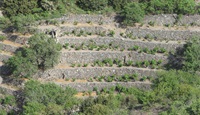
Applicant:
SPS (Société scientifique internationale pour l’étude pluridisciplinaire de la Pierre Sèche) – Cyprus Section
Communities concerned - Bearers of the element:
Community councils, craftsmen, farmers and other villagers of mountainous and semi-mountainous areas where dry stone constructions are found: Pitsilia, Solea, Marathasa, the Limasol wine-villages, Akamas settlements (e.g. Kilani, Vasa, Vouni, Kathikas, Pano and Kato Arodes, Inia, Drousia, Androlikou, Neo Chorio Pafou, Polystypos, Askas, Alona, Platanistasa amongst others).
The technique of drystone also concerns members of international organisations (e.g. SPS: Société scientifique internationale pour l’ étude pluridisciplinaire de la Pierre Sèche, International terraced landscapes Alliance, DSWA Dry stone Wall Association), environmental and folklore organisations, local community associations, professional groups (such as architects, civil engineers, archaeologists, biologists, environment scientists and specialists, geologists and hydroligists), academic institutions and governmental departments.
Domain of Intangible Cultural Heritage:
Oral traditions and expressions
Social practices, rituals and festive events
Knowledge and practices concerning nature and the universe
Traditional craftsmanship
Other(s): traditional rural constructions
Date of inscription:
2015
Geographical location and range of the element:
Drystone constructions in Cyprus are traditionally found in the rural landscape and in specific constructions in urban centres. Today they are preserved in a better condition in the mountainous areas of Cyprus (Pitsilia, Solea, Marathasa) and in semi-mountainous areas (the wine villages of Limassol, Akamas settlements) and to a lesser extent on the plains (Mesaoria plain, Larnaca settlements) and the coastal areas. The highest number of drystone constructions (walls, yards, passages or crossings, various farm buildings) and those best preserved are found in the mountainous and semi-mountainous areas of Limassol and Nicosia: Pitsilia, Marathasa and Limassol wine villages.
Brief Description:
Drystone building refers to the construction of buildings using stones without any binding mortar. It is associated with practices related to the traditional country planning mainly of the rural areas, with the specific character of each area (mountainous, semi-mountainous, and coastal) and with the function of the construction. Drystone constructions are formed according to the knowledge of the properties of the rock and natural materials and the need to tackle natural phenomena. They constitute vital constructions for preventing landslides and floods, for fighting desertification and preserving biodiversity.
The technique can be applied to simple constructions (such as partition and retaining walls, road surfacing) or more complex ones (such as farm buildings for the storage of produce or for processing, animal housing, temporary housing). It is also used for all installations used for land drainage, irrigation and watering. Drystone is preferred due to the advantages of dry construction (insulation, adjustment of ventilation and humidity), but also due to the fact that dry stone constructions do not require any particular technical means. Nowadays, farmers themselves are showing an interest both in building new drystone constructions as well as preserving the existing ones.
The construction of drystone is a collective activity and requires coordination amongst craftsmen and village inhabitants. It is an arduous work which becomes easier when there is collaboration and team work, from the transportation of the raw materials to the cutting of the rock to the laying of the stones and the completion of a dry stone construction. Therefore, this procedure contributes towards strengthening ties between inhabitants and reinforcing the social cohesion within local communities.
At international level, drystone constructions are assuming greater importance in planning landscapes, and forming identities; moreover, their valuable contribution to the natural environment, to the management of land and water resources and to the preservation of historical tradition is acknowledged. Finally, as a technique it offers solutions for restorations and new constructions in various fields of activities hovering between tradition and modernity, craft and artistic creation.
Contacts:
Antonia Theodosiou, Architect, Member of the Conjoint Secretariat of SPS
Address: 4, Lipertis Street, Aglantzia 2121, Nicosia
Phone number: +357 22511397 / +357 99418982
Fax number: +357 22442128
Email address: theodosioua@cytanet.com.cy
Anastasia Pitta, architect engineer – researcher, representative of Cyprus in SPS
Address: P.O.Box. 25144 Nicosia 1307, Cyprus
Phone number: 00357-99528912—00357 22421447
Fax number: 00357-22455572
Email address: a.pitta@cytanet.com.cy